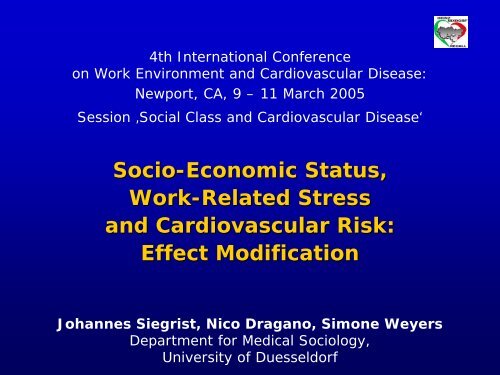Johannes Siegrist, Nico Dragano, Simone Weyers, Raimund Erbel ...
Johannes Siegrist, Nico Dragano, Simone Weyers, Raimund Erbel ...
Johannes Siegrist, Nico Dragano, Simone Weyers, Raimund Erbel ...
You also want an ePaper? Increase the reach of your titles
YUMPU automatically turns print PDFs into web optimized ePapers that Google loves.
4th International Conference<br />
on Work Environment and Cardiovascular Disease:<br />
Newport, CA, 9 – 11 March 2005<br />
Session ‚Social Class and Cardiovascular Disease‘<br />
Socio-Economic<br />
Socio Economic Status,<br />
Work-Related<br />
Work Related Stress<br />
and Cardiovascular Risk:<br />
Effect Modification<br />
<strong>Johannes</strong> <strong>Siegrist</strong>, <strong>Nico</strong> <strong>Dragano</strong>, <strong>Simone</strong> <strong>Weyers</strong><br />
Department for Medical Sociology,<br />
University of Duesseldorf
Background I:<br />
Robust evidence of social gradient of CHD<br />
OR CHD<br />
4<br />
3<br />
2<br />
1<br />
0<br />
I II III IV<br />
Occupational grade<br />
Marmot et al. (1978), JECH, 3: 244-249.<br />
Determinants:<br />
Health care system<br />
Material deprivation<br />
Health-related behaviour<br />
Psychosocial stress, esp.<br />
at work:<br />
- Job Strain (DC)<br />
- Effort-Reward Imbalance<br />
(ERI)
Background II: Inconsistent evidence of social<br />
gradient of stressful work: work:<br />
confirmed (see see<br />
figure) figure)<br />
and unconfirmed findings<br />
Effort-reward<br />
imbalance model:<br />
% imbalance<br />
effort and reward<br />
Demand-control<br />
model:<br />
% job strain<br />
(observer judgement)<br />
high,<br />
middle,<br />
low occupational status<br />
80<br />
60<br />
40<br />
20<br />
0<br />
30<br />
20<br />
10<br />
0<br />
men women<br />
Source: Bosma et al. (1998), Am J Publ Health, 88: 70.
Background III: Reasonable evidence of an association<br />
of stressful work (DC/ERI) with CHD/CVD mortality:<br />
several prospective studies (see figure)<br />
Cardiovascular mortality in industrial workers (25,6 ys.) ys.)<br />
2,5<br />
2<br />
1,5<br />
1<br />
0,5<br />
*<br />
1 2 3 1 2 3<br />
High demand /<br />
low control<br />
Effort-Reward<br />
Imbalance<br />
Source: M. Kivimäki et al. (2002), BMJ, 325: 857<br />
*<br />
Tertiles<br />
1 = low;<br />
2 = intermediate;<br />
3 = high<br />
adj. for age, sex,<br />
occupational group,<br />
smoking, physical<br />
activity, SBP,<br />
total chol., BMI<br />
* p < .05
Research strategy<br />
Given background I-III: III: How to deal with the<br />
association SES - work stress – CHD?<br />
The mediation hypothesis:<br />
hypothesis<br />
low SES work stress CHD<br />
The effect modification hypothesis:<br />
hypothesis<br />
Work stress CHD<br />
low SES
Some evidence of effect modification of the<br />
association between ERI and CHD by SES: SES:<br />
Hazard ratio<br />
highest vs. lowest ERI quartile<br />
Whitehall II-Study II Study; ; 11 year follow-up<br />
follow up<br />
(N=10,308 male and female civil servants)<br />
servants<br />
1,8<br />
1,6<br />
1,4<br />
1,2<br />
1<br />
0,8<br />
All CHD<br />
high SES medium<br />
SES<br />
low SES<br />
Fatal CHD / non-fatal MI<br />
high SES medium<br />
SES<br />
Source: H. Kuper et al. (2002), Occ Environment Med, 59: 777-784.<br />
low SES
Research question<br />
Evidence of effect modification<br />
work stress (ERI) cardiovascular risk factors<br />
by SES?<br />
Heinz-Nixdorf Recall Study (HNRS)<br />
Prospective cohort study in Western Germany<br />
N = 4814 men/women 45-74 years<br />
Sub sample of 1755 working persons<br />
Baseline (2000-2003) of a 5 year-follow-up study<br />
Cardiovascular risk factors<br />
Prehypertension (treated hypertensives!)<br />
Angina<br />
Atherogenic lipids<br />
Depressive symptoms<br />
I. Does ERI vary with cardiovascular risk factors?<br />
II. Does SES modify the effect of ERI on risk factors?
Measures<br />
Socio-economic status:<br />
Education (A-level vs. other); income (median split)<br />
Effort-Reward Imbalance at Work: Combination of<br />
extrinsic (ERI) and intrinsic (OC) components<br />
1) no exposure; 2) intrinsic;<br />
3) extrinsic; 4) combined (high risk)<br />
Prehypertension: Omron measurement<br />
Sys 120-139/Dia 80-89 mmHG (JNC7) [44.2 %]<br />
Angina on exertion: Rose Questionnaire<br />
Pain in chest and on exertion [9.9 %]<br />
HDL Cholesterol: Serum<br />
Results I: Association of<br />
ERI with cardiovascular risk factors* factors<br />
OR** 95 % CI<br />
Prehypertension 1.39 [0.9-1.9]<br />
Angina 2.79 [1.8-4.2]<br />
HDL 1.44 [0.8-2.3]<br />
Depressive symptoms 2.42 [1.7-3.3]<br />
*) unpublished findings, findings,<br />
please do not quote<br />
**) both extrinsic and intrinsic vs. not exposed (reference);<br />
Odds Ratios adjusted for age, gender, smoking, physical<br />
exercise, BMI, (medication), seniority, working hours,<br />
demand-control
Results II: Effect modification by SES<br />
ERI – Angina (an example)*<br />
example)*<br />
OR<br />
3,5<br />
3<br />
2,5<br />
2<br />
1,5<br />
1<br />
0,5<br />
no exposure<br />
*<br />
intrinsic<br />
extrinsic<br />
*) unpublished findings, please do not quote<br />
*<br />
*<br />
both<br />
low income<br />
high income<br />
adjusted for age,<br />
gender, smoking,<br />
sport, BMI,<br />
medication,<br />
seniority, working<br />
hours, demandcontrol
Study limitations<br />
Cross-sectional results<br />
Discussion<br />
Inconsistent findings with regard to SES indicators<br />
Limited validity of self-reported cv. risk factors?<br />
Study strengths<br />
Large representative population study with variety of<br />
occupations (men and women)<br />
High quality data collection (DIN ISO)<br />
Theory-based approach (ERI model; original<br />
measure)<br />
Extensive confounder control
Conclusions<br />
Part of the association SES – work stress –<br />
CHD is elucidated by the effect modification<br />
hypothesis<br />
Preliminary evidence with regard to ERI and<br />
cardiovascular risk factors<br />
If further confirmed, findings are relevant for<br />
preventive strategies at work: vulnerable low<br />
SES workers as primary target group!


